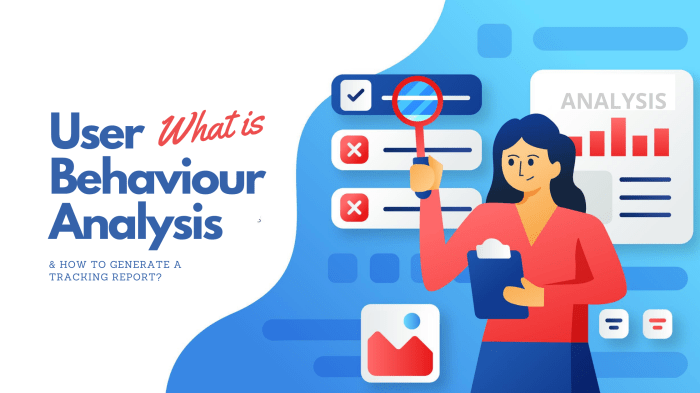User Behavior Analytics, a powerful tool revolutionizing data analysis, delves deep into user actions across various industries, offering a glimpse into the behavior patterns shaping businesses today. From uncovering hidden trends to enhancing customer experiences, this cutting-edge technology is paving the way for informed decision-making and strategic growth.
Introduction to User Behavior Analytics
User Behavior Analytics (UBA) is a process of tracking, collecting, and analyzing user data to gain insights into how users interact with digital platforms. By understanding user behavior patterns, organizations can make informed decisions to improve user experience, enhance security, and boost business performance.
Importance of User Behavior Analytics
- Personalized User Experience: UBA helps in tailoring products and services according to user preferences, leading to higher customer satisfaction and retention.
- Security Enhancement: By monitoring user behavior, suspicious activities can be detected early to prevent cybersecurity threats.
- Optimizing Marketing Strategies: Analyzing user behavior can help in identifying effective marketing campaigns and targeting the right audience for better engagement.
Real-world Examples of User Behavior Analytics
- In E-commerce: UBA is used to track user browsing patterns, purchase history, and cart abandonment rates to optimize product recommendations and enhance the overall shopping experience.
- In Cybersecurity: UBA is employed to detect anomalies in user behavior, such as unusual login times or access from unknown devices, to prevent data breaches and unauthorized access.
- In Social Media: Platforms use UBA to analyze user engagement, content preferences, and interactions to tailor personalized feeds and improve user retention.
Techniques for User Behavior Analytics

User Behavior Analytics involves various techniques for collecting, processing, and analyzing data to understand user actions and patterns. Let’s explore some of the methods used in this field.
1. Data Collection Methods
- Passive Monitoring: This method involves collecting data without the user’s active participation, such as tracking website visits, clicks, and scroll behavior.
- Active Monitoring: In this approach, users are directly engaged to gather data through surveys, questionnaires, or feedback forms.
- Logs and Events: Analyzing server logs and tracking user events can provide valuable insights into user behavior.
2. Data Processing and Analysis
- Data Cleaning: The first step involves removing irrelevant or inaccurate data to ensure the quality of the dataset.
- Pattern Recognition: Utilizing algorithms to identify patterns, trends, and anomalies in user behavior data.
- Statistical Analysis: Applying statistical methods to draw meaningful conclusions and make data-driven decisions.
3. Analytical Techniques, User Behavior Analytics
- Descriptive Analytics: Summarizing historical data to understand what happened in the past.
- Predictive Analytics: Using data to forecast future outcomes and trends based on patterns and behaviors.
- Diagnostic Analytics: Identifying the reasons behind certain user behaviors or outcomes.
Benefits of User Behavior Analytics

Understanding user behavior through analytics can provide numerous benefits for businesses. By analyzing how users interact with a website or application, companies can make informed decisions to improve customer experience, increase engagement, and drive conversions.
Improved Customer Experience
- Personalized Recommendations: User Behavior Analytics can help businesses understand individual preferences and behavior patterns, allowing them to offer personalized product recommendations tailored to each user.
- Optimized User Journeys: By tracking user behavior, companies can identify pain points in the customer journey and make necessary adjustments to streamline the process and enhance overall user experience.
- Enhanced Customer Support: Analyzing user behavior can help businesses anticipate customer needs, proactively address issues, and provide timely support, leading to higher satisfaction levels.
Data-Driven Decision Making
- Identifying Trends: User Behavior Analytics can reveal trends and patterns in user interactions, enabling businesses to make data-driven decisions based on real-time insights rather than assumptions.
- Measuring Campaign Effectiveness: By tracking user behavior before, during, and after marketing campaigns, companies can measure the impact of their efforts and optimize strategies for better results.
- Improving Product Development: Understanding how users engage with products or services can guide product development efforts, helping businesses create offerings that align with customer preferences and needs.
Challenges in User Behavior Analytics
Implementing User Behavior Analytics can come with its fair share of challenges that companies need to address in order to effectively utilize this valuable tool. From data privacy concerns to technical issues, there are several obstacles that organizations may encounter along the way.
One of the common challenges faced when implementing User Behavior Analytics is ensuring the accuracy and reliability of the data collected. Companies need to have a robust data collection process in place to avoid discrepancies and inconsistencies that could impact the results of their analysis.
Another significant challenge is related to data privacy and security. With the increasing focus on protecting user data and complying with regulations such as GDPR, companies need to ensure that they are gathering and analyzing user behavior data in a compliant and ethical manner.
To overcome these challenges, companies can invest in secure data storage and encryption methods to protect user information. Implementing strict access controls and regularly auditing their systems can also help mitigate the risks associated with data privacy and security.
Additionally, organizations can provide transparency to users about the data being collected and how it will be used. By obtaining explicit consent from users and being clear about the purpose of collecting their data, companies can build trust and ensure compliance with privacy regulations.
In conclusion, by addressing challenges related to data accuracy, privacy, and security, companies can effectively leverage User Behavior Analytics to gain valuable insights and improve their decision-making processes.






